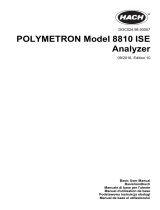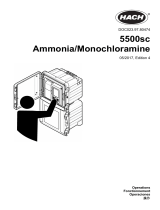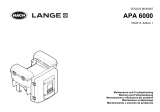
Aztec 600 ISE ammonia and fluoride
Single-stream ion-selective analyzers Contents
OI/AXM630–EN Rev. I 1
Contents
1 Safety ............................................................................... 3
1.1 Health & Safety ........................................................3
1.2 Electrical Safety – CEI / IEC 61010-1:2001-2 ...........3
1.3 Symbols – CEI / IEC 61010-1:2001-2 ...................... 4
1.4 Product Recycling Information .................................5
1.5 Product Disposal ......................................................5
1.6 Restriction of Hazardous Substances (RoHS) ........... 5
1.7 Chemical Reagents ..................................................5
1.8 Safety Precautions ...................................................5
1.9 Safety Conventions ..................................................6
1.10 Safety Recommendations ........................................6
1.11 Service and Repairs ................................................. 6
1.12 Potential Safety Hazards ..........................................6
2 Introduction .....................................................................7
2.1 Operator Display Overview .......................................8
3 Installation .....................................................................10
3.1 Optional Accessories .............................................10
3.2 Sampling Requirements .........................................10
3.3 Location ................................................................. 10
3.4 Mounting ................................................................11
3.4.1 Mounting Dimensions .................................11
3.4.2 Mounting the Analyzer ................................12
3.4.3 Mounting the Optional Reagent Tray ...........12
3.5 Electrical Connections ............................................ 13
3.5.1 Connections Overview ................................14
3.5.2 General Connections ..................................15
3.5.3 Ethernet Connection ...................................16
3.5.4 Alarm Relay Contact Protection and
Interference Suppression ............................16
3.6 Preparing the Analytical Section ............................. 17
3.6.1 Connecting Sample Inlet and Drain Lines ....17
3.6.2 Connecting the Waste Line .........................17
3.6.3 Fitting Peristaltic Pump Pressure Plate ........18
3.6.4 Connecting Reagent
and Calibration Solutions ............................ 19
3.6.5 Ammonia Probe Preparation .......................20
3.6.6 Fluoride Probe Preparation ......................... 21
3.6.7 Fitting the Probe .........................................21
4 Getting Started ..............................................................22
4.1 Overview ................................................................22
4.2 On-line Help ...........................................................23
5 Operation ....................................................................... 24
5.1 Front Panel Controls .............................................. 24
5.2 Navigation and Editing ...........................................24
5.2.1 Text Editing .................................................24
5.2.2 Numeric Editing ..........................................25
5.2.3 Other Methods of Editing ............................25
5.2.4 Menus ........................................................25
5.3 Software Screen Structure .....................................25
5.3.1 Indicator View Menus ..................................25
5.3.2 Chart View Menus ......................................25
6 Configuration ................................................................ 26
6.1 Common ............................................................... 28
6.1.1 Setup ......................................................... 28
6.1.2 Screen ....................................................... 28
6.1.3 Time ........................................................... 29
6.1.4 Security ...................................................... 30
6.1.5 User ........................................................... 33
6.1.6 Operator Messages .................................... 33
6.2 Measurement ........................................................ 34
6.2.1 Setup ......................................................... 34
6.2.2 Streams ..................................................... 34
6.3 Calibration ............................................................. 35
6.3.1 Setup ......................................................... 35
6.4 Alarm Relays ......................................................... 36
6.5 Current Outputs ..................................................... 38
6.5.1 Outputs 1 to 6 ............................................ 38
6.5.2 Output Calibration ...................................... 38
6.6 Logging ................................................................. 39
6.6.1 Chart .......................................................... 39
6.6.2 Recording .................................................. 39
6.6.3 Ranges ...................................................... 39
6.6.4 Archive ....................................................... 40
6.7 Communications ................................................... 41
6.7.1 Ethernet ..................................................... 41
6.7.2 E-mail 1 and E-mail 2 ................................. 42
6.7.3 Profibus ..................................................... 42
6.8 Commissioning ...................................................... 43
6.8.1 Setup ......................................................... 43
7 Logging ......................................................................... 44
7.1 SD Cards .............................................................. 45
7.1.1 SD Card Insertion / Removal ...................... 45
7.1.2 External Media Status Icons ....................... 46
7.2 Reset Archiving ..................................................... 46
7.3 File Viewer ............................................................. 46
7.4 Archive File Types .................................................. 46
7.5 Text Format Data Files ........................................... 47
7.5.1 Text Format Stream Data Filenames ........... 48
7.5.2 Text Format Stream Data –
Example Filenames .................................... 48
7.5.3 Text Format Log Files
(Audit and Alarm Log) ................................. 49
7.5.4 Daylight Saving .......................................... 49
7.5.5 Text Format Data Verification
and Integrity ............................................... 49
7.6 Binary Format Data Files ........................................ 49
7.6.1 Binary Format Data Filenames .................... 49
7.6.2 Binary Format Stream Files ........................ 50
7.6.3 Binary Format Log Files .............................. 50
7.6.4 Daylight Saving .......................................... 50
7.6.5 Binary Format Data Verification
and Integrity ............................................... 50

























